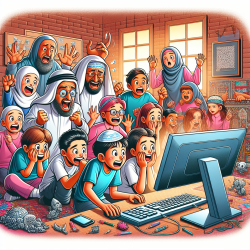Introduction
Cyberbullying is a pervasive issue affecting adolescents worldwide. A recent study titled The Role of Parents and Peers in Cyberbullying Perpetration: Comparison among Arab and Jewish Youth in Israel sheds light on the influence of peers and parents on cyberbullying behaviors among Jewish and Arab teens. This blog explores the findings and their implications for practitioners aiming to mitigate cyberbullying.
Key Findings
The study, conducted with 350 Jewish and Arab adolescents and their parents, revealed several important insights:
- Peer Influence: Both Jewish and Arab adolescents are significantly influenced by their peers when it comes to cyberbullying behaviors. The perception that peers are involved in cyberbullying increases the likelihood of an adolescent engaging in similar behaviors.
- Parental Influence: Contrary to expectations, parental practices such as support, monitoring, and protectiveness did not have a direct effect on cyberbullying perpetration. However, parental protectiveness was found to buffer against sensation-seeking behaviors, which indirectly reduced cyberbullying among Jewish teens.
- Sensation-Seeking: Among Jewish adolescents, sensation-seeking behaviors were positively associated with cyberbullying, whereas this was not the case for Arab adolescents.
Implications for Practitioners
Practitioners can leverage these findings to improve their strategies in addressing cyberbullying:
- Focus on Peer Norms: Since peers have a significant influence, interventions should include peer-led initiatives that promote positive online behaviors and discourage cyberbullying.
- Enhance Parental Engagement: While direct parental influence was not significant, encouraging parents to engage in open dialogues about online risks can still be beneficial. Practitioners should guide parents on how to effectively communicate and set boundaries regarding digital behaviors.
- Address Sensation-Seeking: For Jewish adolescents, programs that offer safe outlets for sensation-seeking may reduce the inclination towards cyberbullying. Activities that channel their need for excitement into positive experiences can be effective.
Encouraging Further Research
The study highlights the need for further research into the cultural dynamics affecting parental influence and the role of sensation-seeking across different ethnic groups. Practitioners should advocate for more comprehensive studies that explore these variables in various contexts to develop tailored interventions.
Conclusion
Understanding the roles of peers and parents in cyberbullying among different cultural groups provides valuable insights for practitioners. By focusing on peer influence and enhancing parental engagement, practitioners can develop more effective strategies to combat cyberbullying.
To read the original research paper, please follow this link: The Role of Parents and Peers in Cyberbullying Perpetration: Comparison among Arab and Jewish and Youth in Israel.










